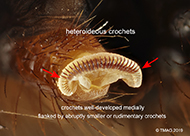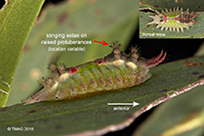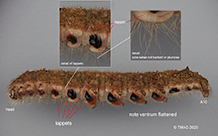Access The Caterpillar Key here
The Caterpillar Key is now live and freely available to use. It is a new tool for the identification of caterpillars to family level, with a focus on families of biosecurity and economic concern to Australia.
Why this key?
Lepidoptera (moths and butterflies) are one of the largest orders of animals in the world. There are over 180,000 named species of Lepidoptera (10% of all named organisms), and at least one-third that number again are yet to be described.
While a lot is known about adult insect species, the larval or immature stages (i.e. caterpillars) of many are poorly understood. Descriptions of immature stages and identification keys are mostly lacking, unpublished or scattered throughout the literature.
About the key
Identification or lucid keys are tools that allow us to identify species or groups of organisms based on morphological characteristics.
The Caterpillar Key includes around 100 of the approximately 130 families of Lepidoptera. As such, the key is broadly applicable to most caterpillars encountered in Australia during border interceptions, in field collections, or by the public.
The key has been designed to optimise rapid identification of most caterpillar specimens to the family level. In some cases, identification will be difficult and may not arrive at just one family, but several. Other resources may then need to be used to reach a more refined diagnosis.
The design is user-friendly so that the path to identification is as short as possible, however, to make the most of the key make sure you read the How to Use guide first.
Fact sheets are also included in the key for families of biosecurity importance to support identification. The developers hope to eventually provide fact sheets for all families.
Benefits to the community
- As caterpillar larvae is difficult to identify, the key is an important tool in the arsenal for preventing the establishment of exotic pests. It will be used to identify pest caterpillars arriving at ports on plants and plant products.
- Members of the public are also becoming increasingly interested in identifying the animals they see around them and education about identification enhances the ability of the public to detect new pests. Further, the key will not only assist in identification, but highlights the amazing diversity of Lepidoptera and the quirky morphology of caterpillars.
Development of the key
Dr Cathy Byrne (Senior Curator of Zoology) and Di Moyle (honorary curator) from the Tasmanian Museum and Art Gallery were contracted by the Australian Government Department of Agriculture, Water and the Environment to develop the key.
They scoured the literature for information on caterpillars, examined specimens and painstakingly recorded data on hundreds of anatomical features for each family to gather the information required to enable the key to distinguish between most caterpillars encountered at the border or in the bush.
The Caterpillar Key took over a year to develop, with the last six months focussed on testing and fine tuning. While it is now live the key is a dynamic product and the developers encourage users to contact them with any suggestions or comments.
Acknowledgements
Funding – Federal Department of Agriculture, Water and the Environment.
Authors – Diane Moyle and Dr Cathy Byrne
Further acknowledgements – Craig Marston (Department of Agriculture) for administering the project, encouragement and advice. Stacey Anderson (Department of Agriculture) for the loan of specimens of caterpillars of biosecurity concern from the North Australia Quarantine Service (NAQS) Cairns and Darwin collections. Matt Taylor from Lucid, for assistance using the Lucid software.



